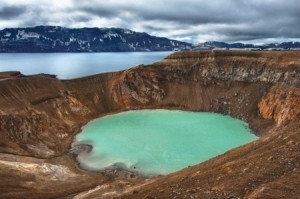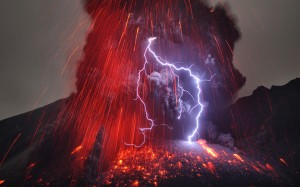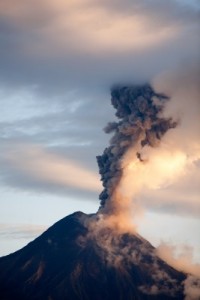
Askja volcano offers a view of two crater lakes. The smaller, turquoise lake contains warm geothermal water and is good for swimming. The large lake is the second deepest lake in Iceland. Both are part of a MASSIVE volcanic crater.
Humans don’t realize how TINY we are. Stand next to a volcanic crater, and you’ll realize just how small you are in comparison to a massive, explosive hole in the Earth.
When volcanoes erupt, they are much more dangerous than most people think. When several volcanoes erupt at once, the impact is far more devastating than we can imagine.
Active Volcanoes Today
Between November 27 – December 3, 2013, Smithsonian/USGS reported activity at the following volcanoes – activity ranging from active volcanoes to new activity to unrest:
- Etna, Sicily (Italy)
- Kliuchevskoi, Central Kamchatka (Russia)
- Nishimo-shima, Japan
- Sinabung, Sumatra (Indonesia)
- Shiveluch, Central Kamchatka (Russia)
- Chirinkotan, Kuril Islands
- Chirpoi, Kuril Islands (Russia)
- Karymsky, Eastern Kamchatka (Russia)
- Kilauea, Hawaii (USA)
- Manam, Northeast of New Guinea (SW Pacific)
- Pacaya, Guatemala
- Rabaul, New Britain
- Sakura-jima, Kyushu
- Suwanose-jima, Ryukyu Islands and Kyushu
- Ulawun, New Britain
Earth’s Internal Heat

Volcanic eruptions are the result of the Earth’s internal heat releasing pressure.
Fueled by both internal and external forces, the Earth remains in a dynamic state of motion.
Its internal heat is caused by radioactivity in the crust and from heat that rises up from a molten-metal core that is hotter than the surface of the Sun. This heat melts rocks, creates volcanoes, and thrusts mountains upward.
The Earth’s crust expands from this intense, interior heat, and today, this is breaking the continents apart and heating up many global volcanoes.
As the crust gets warmer, sea levels rise and fill the widening spaces between land masses with fast-moving salt water.
The Earth is in full force motion today, and after 200 million years, the Earth’s many volcanoes are waking up.
Heads Up – it’s time to prepare for an increase in weather changes, rising sea levels, and atmospheric ash!


